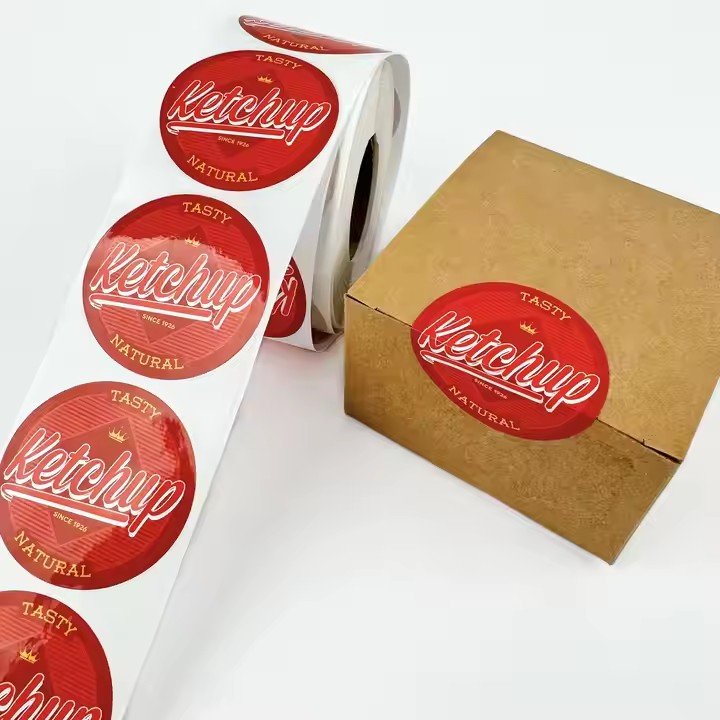I. Core Material Categories and Characteristics
The material of a small sticker consists of two main parts: the base material and the adhesive layer.
The base determines the sticker’s appearance and durability, while the adhesive affects its bonding strength and application scenario.
Common sticker materials fall into three categories — paper-based, plastic-based, and functional specialty materials — each with distinct performance traits.
- Paper-Based Materials: Low Cost and Easy Printing — Ideal for Indoor Short-Term Use
Paper is the most basic and affordable sticker substrate. It supports various printing methods (inkjet, laser, thermal) but generally lacks water and scratch resistance, making it suitable for indoor, low-contact use.
Coated Paper (Art Paper):
Has a coated surface that delivers vivid colors and a smooth texture. Commonly used for product packaging labels and journal decorations.
Drawback: Not waterproof — easily tears or smudges when exposed to moisture, so it should be kept away from humid environments.

Kraft Paper:
Naturally textured with a vintage look and higher tear resistance than coated paper. Ideal for retro-style labels or organizing stickers. Some kraft papers can be treated with a waterproof coating for short-term moisture resistance, though prolonged exposure still causes softening.
Matte Paper:
Non-glossy, delicate in texture, and ensures clear, glare-free printing — suitable for labels that are frequently read (e.g., file tabs, bookshelf markers).
Drawback: Prone to scratching; avoid frequent rubbing.
- Plastic-Based Materials: High Durability and All-Scenario Adaptability — Ideal for Long-Term Use
Plastic materials are preferred for outdoor or high-contact applications due to their waterproof, scratch-resistant, and weatherproof properties. The most common types are PVC, PET, and PP, each differing in hardness, transparency, and environmental performance.
PVC (Polyvinyl Chloride):
The most cost-effective option with excellent flexibility — easy to apply to curved surfaces (like cups or gift boxes). Highly water- and scratch-resistant, available in transparent, white, or colored forms.
Drawbacks: Not heat-resistant (warps above 60°C) and low-cost variants may contain plasticizers, making them unsuitable for children’s products or food-related applications.
PET (Polyethylene Terephthalate):
Harder and more dimensionally stable than PVC, heat-resistant (up to 120°C short-term), odor-free, and environmentally friendly. Suitable for food labels (bottle stickers) and electronics (phone or device decals).
Transparent PET offers a “no-label” appearance, while white PET provides vivid color reproduction and strong UV resistance — lasting 1–2 years outdoors without fading.
PP (Polypropylene):
Lightweight, chemically resistant (can withstand contact with alcohol and oils), and flexible without breaking — ideal for kitchen stickers (fridge labels, spice jars) and automotive interior decals.
Drawback: Has weak ink adhesion, so surface treatment is required before printing to prevent peeling.
- Functional Specialty Materials: Solving Specific Use-Case Challenges
For unique performance needs such as waterproofing, UV resistance, removability, or high-temperature endurance, functional base materials offer tailored solutions.
Waterproof Film Stickers:
A transparent waterproof film (such as OPP or PE) is laminated on paper or PET surfaces to enhance water and scratch resistance — ideal for bathroom décor or cup stickers.
Note: The film protects only the surface; if the adhesive is water-based, prolonged soaking may still cause peeling.
Removable Adhesive Stickers:
Use low-tack adhesive formulas that peel off cleanly without residue — perfect for temporary decorations (holiday decals, rental wall art) or children’s stickers.
Drawback: Lower bonding strength, not suitable for heavy-duty or outdoor use.
Reflective / Glow-in-the-Dark Stickers:
Contain reflective particles or phosphorescent powder. Reflective types bounce back light (for safety signs, car decals), while glow-in-the-dark types emit light after absorbing it (for emergency exits, toys).
Usually made with PET base for durability, though color-printing options are limited.

II. Five Key Factors When Choosing Sticker Materials
When selecting a sticker material, consider the usage scenario and evaluate five core dimensions: adhesion strength, durability, print compatibility, environmental safety, and cost.
Avoid focusing only on appearance — performance matching is essential for practical use.
- Adhesion Strength: Match the Surface and Duration of Use
The adhesive determines bonding strength. Using the wrong type may result in stickers that won’t stick or can’t be removed properly.
Low-Tack Adhesive:
Light adhesion, easy to remove without residue — ideal for smooth surfaces (glass, tile, plastic) and temporary uses like seasonal window art or short-term labeling.
Medium-Tack Adhesive:
Balanced adhesion, suitable for longer indoor use (6–12 months) with only light residue after removal (can be wiped off). Common for bookshelf, furniture, or product labels.
High-Tack Adhesive:
Very strong bond, can withstand friction or vibration — best for outdoor use (vehicle decals, outdoor signage) or rough surfaces (cardboard, wood).
Drawback: Hard to remove, may damage painted or coated surfaces (like wall paint).
- Durability: Choose Resistance According to Environment
Durability depends on resistance to water, abrasion, temperature, and sunlight — these directly affect the sticker’s lifespan.


